The Ecstasy of Saint Teresa: A Masterpiece of Baroque Art
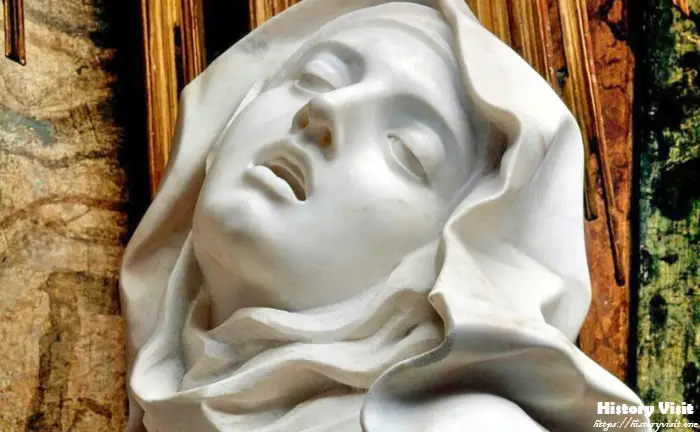
Introduction
The “Ecstasy of Saint Teresa,” a masterwork by Gian Lorenzo Bernini, stands as one of the most significant sculptures of the Baroque period. Created between 1647 and 1652, this remarkable piece is housed in the Cornaro Chapel of Santa Maria della Vittoria in Rome. It portrays the spiritual rapture of Saint Teresa of Ávila, a Spanish mystic and nun of the Carmelite order, as described in her autobiography. This sculpture is renowned for its emotional intensity, dramatic use of light and shadow, and intricate details that embody the essence of Baroque art.
Bernini, a preeminent figure in Baroque sculpture and architecture, was commissioned by Cardinal Federico Cornaro to create this work for his family chapel. The commission was part of a broader effort by the Catholic Church during the Counter-Reformation to inspire faith and devotion through compelling and emotionally engaging art. Bernini’s work not only fulfilled this goal but also set new standards for artistic expression, blending architecture, sculpture, and theatrical elements into a cohesive whole.
In this article, we will explore the historical and artistic context of the “Ecstasy of Saint Teresa,” delve into its detailed description and artistic techniques, interpret its symbolism and meaning, and examine its lasting impact and legacy. Through these lenses, we will gain a comprehensive understanding of why this sculpture is celebrated as a pinnacle of Baroque art.
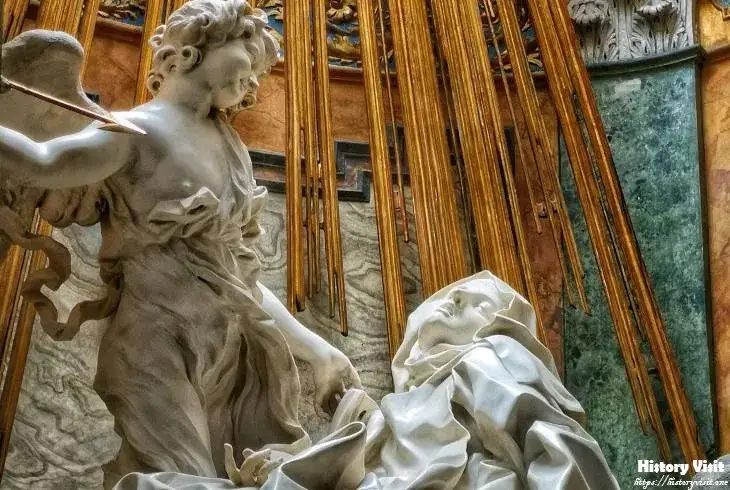
Baroque Art Movement
The Baroque art movement, which spanned from the late 16th century to the early 18th century, is characterized by its dramatic, elaborate, and highly detailed artistic style. Originating in Italy, the movement quickly spread across Europe, influencing painting, sculpture, architecture, and music. Baroque art is distinguished by its emphasis on movement, contrast, emotional exuberance, and a tendency to blur the boundaries between various forms of art.
Gian Lorenzo Bernini was a central figure in the Baroque period, known for his dynamic and emotive sculptures. His work is marked by a masterful use of light and shadow, as well as a keen ability to convey intense emotion through his figures. Bernini’s contributions to Baroque art were not limited to sculpture; he was also an accomplished architect and painter, often integrating these disciplines to create immersive experiences.
The “Ecstasy of Saint Teresa” exemplifies the Baroque fascination with depicting the divine and mystical experiences with vivid realism and theatricality. Bernini’s ability to capture the climactic moment of Saint Teresa’s spiritual vision, combined with the intricate detailing and dramatic composition, showcases the quintessential features of Baroque art. This sculpture remains a defining example of the period’s artistic ambitions and achievements.
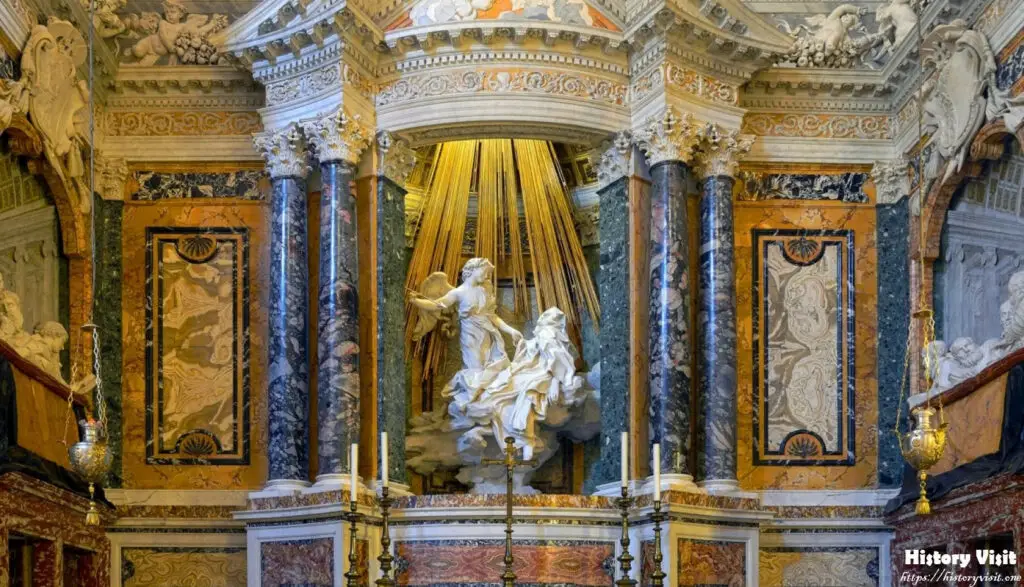
Commission and Creation
The “Ecstasy of Saint Teresa” was commissioned by Cardinal Federico Cornaro for his family chapel in the church of Santa Maria della Vittoria, Rome. Cornaro, a member of a wealthy and influential Venetian family, sought to create a lasting legacy through the beautification of his family’s chapel. His choice of Bernini, who was already a celebrated artist by that time, ensured that the project would receive the highest level of artistic execution.
Bernini began work on the sculpture in 1647, and it was completed in 1652. The process involved meticulous planning and execution, reflecting Bernini’s dedication to his craft. He employed a combination of marble for the figures, stucco for the architectural elements, and gilt bronze for the rays of divine light, creating a rich and multifaceted visual experience. The use of multiple materials was a hallmark of Bernini’s approach, allowing him to achieve a greater sense of depth and realism.
The Cornaro Chapel itself was designed to enhance the theatrical presentation of the sculpture. Bernini incorporated a stage-like setting, with the Cornaro family members depicted in relief on the side walls as if they are watching the mystical event unfold. This innovative integration of sculpture and architecture creates an immersive experience for viewers, drawing them into the spiritual narrative depicted in the central tableau.
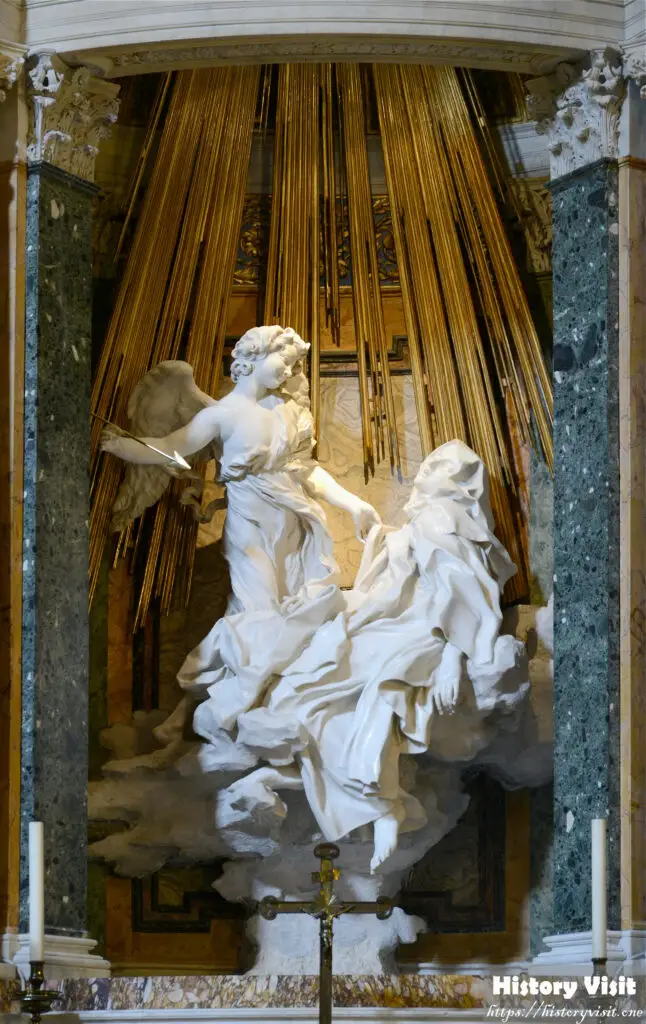
Description of the Sculpture
The “Ecstasy of Saint Teresa” features Saint Teresa in a state of spiritual rapture, reclining on a cloud as an angel stands above her, holding a golden arrow. The angel, with a serene and gentle expression, appears to be guiding Teresa into her ecstatic vision. Teresa’s face is contorted in a mixture of pain and pleasure, reflecting the intensity of her mystical experience. The delicate handling of her drapery further emphasizes the ethereal and otherworldly nature of the moment.
The use of marble allows for a striking contrast between the soft, flowing textures of the fabrics and the solidity of the figures. Bernini’s skillful carving techniques create a sense of movement and lightness, making the figures appear almost weightless. The golden rays emanating from behind the figures symbolize divine light, adding to the overall sense of heavenly intervention and spiritual transcendence.
Surrounding the main figures are additional sculptural elements that contribute to the narrative. The reliefs of the Cornaro family on the side walls act as witnesses to the divine event, adding a layer of realism and engagement. This arrangement not only enhances the storytelling aspect of the sculpture but also demonstrates Bernini’s ability to merge different artistic elements into a cohesive whole.
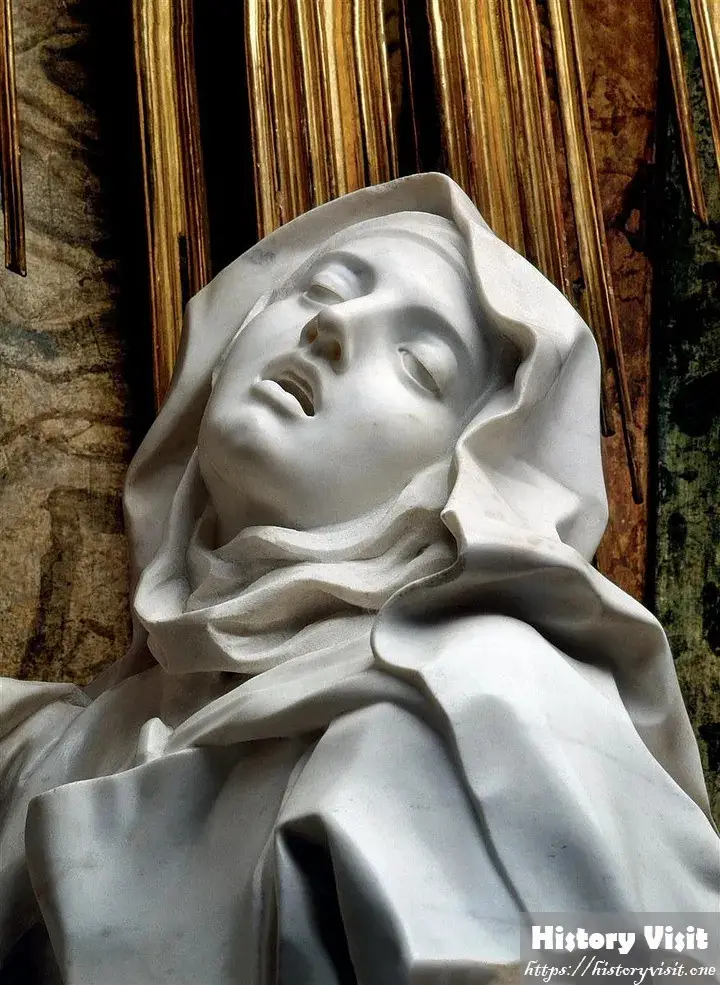
Artistic Techniques
Bernini’s artistic techniques in the “Ecstasy of Saint Teresa” are a testament to his mastery of the medium and his innovative approach to sculpture. One of the most notable techniques is his use of light and shadow to create a dramatic and immersive effect. The chapel’s architecture is designed to allow natural light to filter through strategically placed windows, illuminating the sculpture and enhancing the play of light on the marble surfaces.
The drapery in the sculpture is another example of Bernini’s technical prowess. The flowing robes of Saint Teresa and the angel are rendered with such precision and delicacy that they seem to defy the rigid nature of marble. This creates a dynamic sense of movement, as if the fabrics are gently billowing in a divine breeze. The contrast between the heavy, voluminous folds and the light, delicate sections adds to the overall realism and emotional impact of the piece.
Facial expressions and body language are crucial in conveying the spiritual intensity of the scene. Bernini’s ability to depict subtle nuances of emotion is evident in the angel’s serene smile and Saint Teresa’s ecstatic contortion. These expressions draw the viewer into the psychological and emotional depths of the figures, making the mystical experience depicted in the sculpture palpable and relatable.
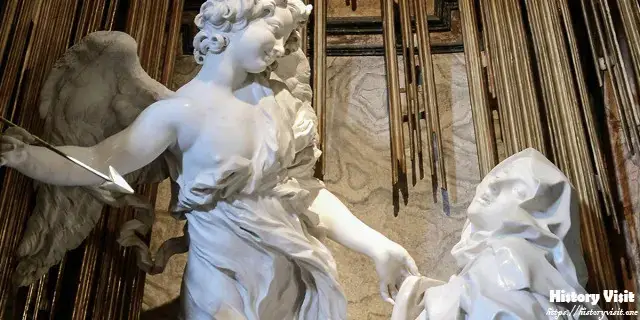
Interpretation and Meaning
The “Ecstasy of Saint Teresa” is rich in symbolic meaning, rooted in the mystical experiences of Saint Teresa of Ávila as described in her autobiography. The sculpture captures the moment of her spiritual vision in which an angel pierces her heart with a divine arrow, symbolizing the profound union with God through ecstatic love. This moment is portrayed with an intensity that conveys both physical and spiritual dimensions of her experience.
Saint Teresa’s expression and posture reflect a mixture of pleasure and pain, symbolizing the dual nature of her mystical encounter. The angel’s gentle demeanor contrasts with the intensity of Teresa’s reaction, highlighting the transcendence of divine love that surpasses human understanding. The golden arrow held by the angel represents the divine intervention and the inflaming of Teresa’s heart with the love of God.
The sculpture also serves as a visual representation of the Counter-Reformation ideals, emphasizing the power of mystical experiences and personal devotion as means to connect with the divine. By depicting such an intimate and powerful moment of spiritual ecstasy, Bernini’s work aimed to inspire faith and devotion in viewers, reinforcing the Catholic Church’s message during a time of religious upheaval and reform.

Impact and Legacy
The “Ecstasy of Saint Teresa” has had a profound impact on both contemporary and subsequent art. At the time of its creation, the sculpture was celebrated for its innovative use of materials, dramatic composition, and emotional depth. It set a new standard for religious art, demonstrating how sculpture could convey complex spiritual narratives with unparalleled realism and emotional resonance.
Bernini’s work influenced many artists of the Baroque period and beyond, inspiring them to explore similar themes of divine intervention and spiritual ecstasy. The integration of sculpture, architecture, and theatrical elements in the Cornaro Chapel became a model for future works, emphasizing the importance of creating immersive environments that engage viewers on multiple sensory levels.
The enduring legacy of the “Ecstasy of Saint Teresa” is evident in its continued admiration and study by art historians, scholars, and artists. It
remains a focal point of scholarly analysis and public fascination, reflecting the timeless appeal of Bernini’s genius. The sculpture’s ability to evoke profound emotional responses and convey complex spiritual themes ensures its place as a cornerstone of Baroque art and a masterpiece of Western artistic heritage.

Conclusion
The “Ecstasy of Saint Teresa” by Gian Lorenzo Bernini is more than just a sculpture; it is a confluence of art, theology, and emotion that epitomizes the Baroque era’s artistic achievements. Commissioned by Cardinal Federico Cornaro and completed between 1647 and 1652, this masterpiece resides in the Cornaro Chapel of Santa Maria della Vittoria in Rome, where it continues to captivate viewers with its dramatic representation of Saint Teresa of Ávila’s mystical experience.
Through a meticulous blend of marble, stucco, and gilt bronze, Bernini created a dynamic and immersive work that highlights the spiritual fervor and emotional intensity of Saint Teresa’s divine vision. His innovative use of light and shadow, coupled with the lifelike depiction of textures and expressions, brings the sculpture to life, making the viewer a participant in the mystical event.
The legacy of the “Ecstasy of Saint Teresa” extends beyond its immediate impact on Baroque art. It set new standards for religious sculpture, influenced countless artists, and continues to inspire awe and reverence. This sculpture remains a testament to Bernini’s unparalleled skill and his ability to convey the profound mysteries of faith through the medium of art, ensuring its place in the annals of art history as a timeless and transformative work.


